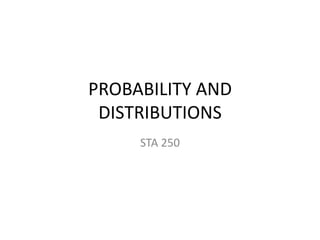
06 samples and-populations
- 2. So Far • Learned to describe a distribution through its shape, central tendency, and variability • Used z-scores to locate and compare individual scores • Applied the rules of probability to determine the likely hood of obtaining that score in a sample • However, we have only dealt with samples consisting of a single score. • Most research uses far larger samples to represent a population.
- 3. More About Populations and Samples • A POPULATION is a universe of individuals who share at least one characteristic the study is interested in. • A SAMPLE is a subgroup from within the population. • The natural discrepancy or difference between a SAMPLE and the POPULATION it was drawn from is SAMPLING ERROR • Multiple SAMPLES can be drawn from the same population • Statistics can be calculated for each of these SAMPLES • Each SAMPLE will be different from the POPULATION and other SAMPLES
- 4. Distribution of Sample Means • So far we have seen two types of distributions: 1. Distribution of scores for a population of individuals 2. Distribution of scores for a particular sample drawn from a population • Now we add a third 3. Distribution of means of all possible samples of a particular size taken from a distribution
- 5. Distribution of Sample Means • The Distribution of Sample Means is the collection of sample for all the possible random samples of a particular size (n) that can be obtained from a population – Contains all possible combination for a specific n – Comprised of the statistics (means) for each of the samples – Also referred to as a sampling distribution, or sampling distribution of M.
- 6. SAMPLING DISTRIBUTION • Sampling distribution is a distribution of samples from the same population distribution
- 7. Distribution of Sample Means • We would expect that if you repeatedly drew samples and recorded the means the following would be true – The sample means would pile up around the population mean – The pile of sample means would tend to form a normal-shaped distribution • The most often occurring in the middle close to population mean • The least often occurring on the outside away from population mean – The larger the sample size the closer the sample means will be to the population mean
- 8. Think of Each Square as a Individual Sample Mean
- 9. Consider • If the population consisted of only 4 scores: 2, 4, 6, 8, and we wanted to construct a distribution of sample means for the sample size n=2 • When we listed every possible sample that could be drawn from this population (16) • Calculated the mean for each sample • Then graphed the means using a histogram
- 10. We Would Find
- 11. We Would Find
- 12. Central Limit Theorem For any population with mean μ and standard deviation σ, the distribution of sample means for a sample size n will have a mean of μ and a standard deviation of and will approach a normal distribution as n approaches infinity • Includes central tendency, variability, and shape of distribution
- 13. What This Means • Describes the distribution of sample means for any population no matter what shape, mean, or standard deviation. • The mean of all the sample means will be the same as the population mean • The normality of the distribution increases as the sample size increases. When n=30 the distribution is almost perfectly normal.
- 14. Mean of the Distribution of Sample Means • The mean of a distribution of sample means is is called the expected value of M • Signified by M • The mean expected value of M will always be equal to the population mean μ M=μ
- 15. Standard Deviation of the Distribution of Sample Means • The standard deviation for the distribution of sample means is called the standard error of the mean or M. • Just like the standard deviation the standard error of the mean represents the average distance between each sample mean and the mean of the distribution of means. • Signified by
- 16. Standard Error of M • Tells us • How much difference is expected from one sample to another. – The larger the standard error the more spread out the distribution – The smaller the standard the more clustered the distribution • How well an individual sample mean represents entire distribution. – Because M=μ it also tells us how much difference there is between the M and μ. Check of sampling error
- 17. Standard Error of M • Magnitude of the standard error determined by : – Sample size (Law of Large Numbers) • The larger the sample size the more probable it is that the sample mean will be close to the population mean – Standard deviation of the population • The starting point for standard error. When n=1 standard error and standard deviation are the same • Inverse relationship between sample size and standard error • Formula
- 18. As Sample Size Increases Standard Error Decreases
- 19. Example • The GRE has mean of 500 and standard deviation of 100. If many samples of n=50 students are taken: – Mean of distribution of means is 500 – What is the SE of Mean? • Formula: – Shape of distribution will be normal.
- 20. Probability and the Distribution of Sample Means • Because the distribution of sample means is a normal distribution, z-scores and the unit normal table can be used to find probability • The z-score formula does change in notation but not concept